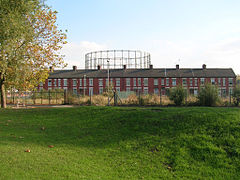Miles Platting
| Miles Platting | |
|---|---|
 A row of terraced houses in Miles Platting |
|
| Miles Platting shown within Greater Manchester | |
| OS grid reference | SJ856992 |
| • London | 163 mi (262 km) SE |
| Metropolitan borough | |
| Metropolitan county | |
| Region | |
| Country | England |
| Sovereign state | United Kingdom |
| Post town | MANCHESTER |
| Postcode district | M40 |
| Dialling code | 0161 |
| Police | Greater Manchester |
| Fire | Greater Manchester |
| Ambulance | North West |
| EU Parliament | North West England |
| UK Parliament | |
Miles Platting is an inner city district of Manchester, England. It is 1.4 miles (2.3 km) east-northeast of Manchester city centre, along the course of the Rochdale Canal and A62 road. It is bound by the localities of Monsall, Collyhurst, Newton Heath, Bradford and Ancoats.
Historically a part of Lancashire, and formerly a part of the township of Newton Heath, Miles Platting began to appear on maps in the 1820s, when it had begun to expand into a factory district as a result of the Industrial Revolution. That industrial growth resulted in a population that became very large for the size of the district, resulting in densely packed terraced housing that had degenerated into slums by 1950.
Today, Miles Platting is part of the East Manchester Regeneration Scheme and is undergoing extensive redevelopment and regeneration as some of the last vestiges of the Industrial Revolution are removed.
The origin of the name remains uncertain, but one suggestion is that it may derive from the word platt, meaning a small piece of ground, with miles being a corruption of mills. Hence Miles Platting may mean "mills on a small piece of ground".
Miles Platting certainly did have many mills by the middle of the 19th century: Holland Mill, Victoria Mill and Ducie Mill were among the largest. By the 1870s a chemical works, timber yard, gas works and a tannery were also operating in the area alongside the many mills. This volume of industry in such a relatively small area inevitably led to the construction of densely packed back-to-back housing to provide homes for the necessary workforce. By the middle of the 20th century, with the decline in manufacturing industry and the closure of its local industries, Miles Platting had become a slum area inhabited by a deprived, largely white, community. Today, Miles Platting contains just under 2,000 housing units, many of them managed by Adactus Housing Association on behalf of Manchester City Council, including 12 multi-storey blocks. The area, once recognised as being amongst the most deprived in the UK, has benefited greatly from the very substantial urban regeneration scheme for east Manchester initiated in the late 1990s.
...
Wikipedia

